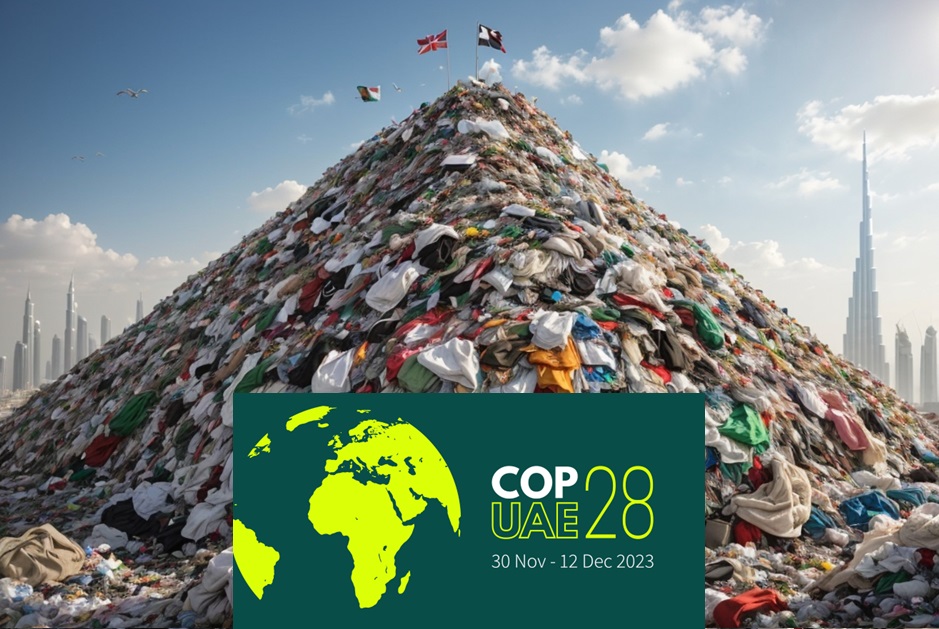Reflecting on COP 28 which it closed its doors on the 12th of December 2023 in Dubai, the event has again a spotlight on the fashion industry and the urgent need to reduce overproduction, overconsumption and waste, fast.

In an overall review of the industry’s advancements to achieving net positive impact by 2030, the Global Fashion Agenda (GFA) Assembly presented a report at COP, on 5 December 2023, that highlighted that current trajectories show the industry still exceeding critical limits if change is not accelerated and the gap between ambition and action is widening. Circularity rates have declined from 9.1% in 2018 to 7.2% in 2023, and 90% of materials are still wasted, lost or neglected.

Whilst everyone in the fashion industry, including uniform and professional clothing companies, have a responsibility in helping to reduce the industry’s impact, this year the experts at COP have focussed largely on the industry’s most impactful sector, the fast fashion model. Seen as the most wasteful of the apparel sectors, discussions focussed on curbing the practices that have made fast fashion one of the most influential apparel industries on the planet. This high-consumption sector is responsible for eight to ten percent of global carbon emissions as its “pile them high, sell them cheap” business model thrives on cheap fossil-fuel-based fibres and cheap labour, made possible by social and environmental injustice.
Addressing the issues that make it acceptable to over-produce and waste on such a huge scale is a step in the right direction. Experts at the conference agreed that speeding up fashion’s transition to renewables is key to reducing the industry’s footprint. Easier said than done, several discussion streams looked at ways in which this may be made a reality.
The EU launched its Global Pledge on Renewables and Energy Efficiency at COP28, which has set global targets to triple the installed capacity of renewable energy and double the rate of global energy efficiency improvements by 2030. This is a key consideration for all who sell, import or manufacture in the EU.
With most textile and fashion factories based in the Global South where renewable energy is largely unheard of and workers’ rights are often highly neglected, the challenge is stark. This is why much of the discussions also centred on better climate finance and debt relief for developing countries such as Vietnam, Bangladesh and Pakistan, which are heavily involved in the fashion supply chain.

Climate funding is essential to speed up investment in alternative textiles and technologies that are less resource-intensive. Investment will also tackle the social inequality that pervades the industry and is exacerbated by climate change. Low wages and inadequate worker welfare make it possible for low cost, fast fashion to thrive as over-production and waste do not present barriers to the big brands.
These are considerations for everyone in the industry, not just t he fast fashion brands. Many of the textiles we use in the uniform industry are also fossil fuel based and are made in countries where renewables are not common and social injustices are prevalent. Driven by the fast fashion model, over-production has become the norm for many manufacturers. We can change this though and the uniform and professional clothing industry is in a good place to do so. The first steps to waste reduction begin at home. By providing wearers with better fit and sizing tools such as Bodi.Me’s award-winning Size-Me platform, wearers can make better decisions and help to reduce returns. When taken into consideration that the majority of returned garments end up in landfill or are incinerated rather than resold, this is a big consideration and also a cost saver for the company.
Data holds the key to reducing over-production and Size-Me also collects data that can help the brand and manufacturer make better production decisions in terms of how many garments of what style or size is really needed, rather than placing huge orders of which much will end up being wasted. Size-Me is easy to incorporate into existing systems and with its non-invasive sizing measures is super easy to use.
The latest legislation, plus any new legislation to come out of the discussions at COP will impact us all. Importantly, it will also impact the brands that purchase the uniforms we make or supply to them as eventually, all sectors will need to report on a range of sustainability metrics, not to mention the consumer’s expectations and reputation management in a world that expects brands to act responsibly. By incorporating the right climate tech and user tools such as Size-Me, and tapping into the huge benefits they bring both financially and for the environment, businesses are taking a big step towards future-proofing their businesses.


